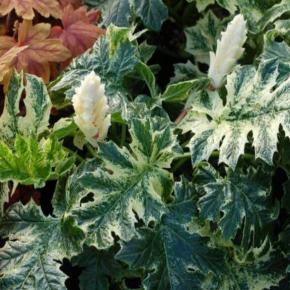Renowned for its large, lobed, glossy green leaves and striking floral spikes, Acanthus mollis is an ornamental perennial with an impressive presence. Native to Mediterranean regions, it offers a spectacular summer bloom, perfect for adding structure to borders and flower beds. Its hardiness and adaptability to various soil types make it a must-have for elegant, low-maintenance gardens.
|
Packaging
To find out more about our packaging, please visit our young plants' page available from the website header.

|
Available quantity | Dispo à partir de | Sold by | Desired quantity | |
|---|---|---|---|---|---|
|
Le stock n'est actuellement pas disponible pour ce produit. |
|||||
Features of Acanthus mollis
Acanthus mollis is characterized by its broad, deeply lobed leaves, forming a dense clump that can reach up to 1.5 m in height. Its summer bloom is marked by upright spikes adorned with elegant white and purplish flowers. Suited to temperate climates, this plant tolerates temperatures as low as -15°C. It thrives in rich, well-drained soil and benefits from a sunny to lightly shaded position.
How to Use Acanthus mollis ?
With its striking form and graphic flowers, Acanthus mollis is ideal for flower beds, borders, or as a backdrop for mixed planting schemes. Its ability to structure spaces makes it an excellent choice for Mediterranean-style gardens. It can also be grown in pots for shaded patios. Whether used as a low hedge or a screen, it adds a natural touch while defining garden spaces. Pair it with other perennials or shrubs for a stunning visual effect.
Tips for Growing Acanthus mollis
Acanthus mollis thrives in rich, deep, and well-drained soil but can also adapt to stony ground. Plant it in autumn or spring, spacing each plant 60 to 80 cm apart to allow room for growth. Water regularly during the first few weeks, then reduce watering as it becomes established. Prune faded flowers to encourage new growth. At the end of the season, applying mulch can protect the plant in colder regions. Fertilize once a year with compost or organic fertilizer to promote healthy growth.









